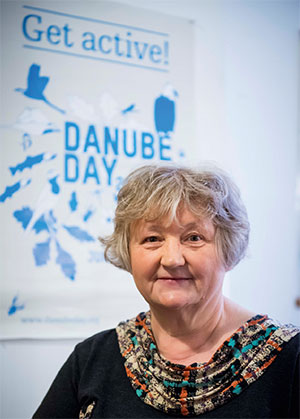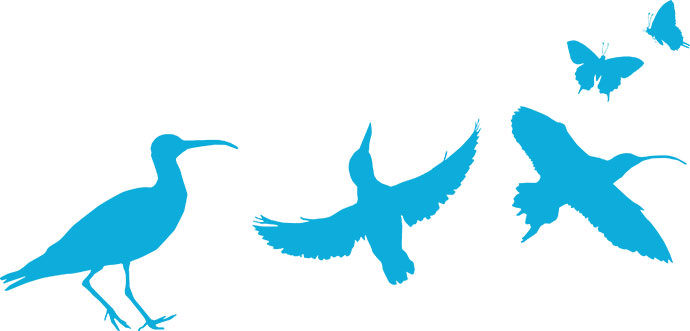Danube Watch 2/2017 - Danube Day Reflecting on the development of the world’s largest river event
Danube Day
Reflecting on the development of the world’s largest river event
 An interview with Maria M. Galambos, Chief Adviser, Department for International Relations at the Ministry of Agriculture in Hungary
An interview with Maria M. Galambos, Chief Adviser, Department for International Relations at the Ministry of Agriculture in Hungary
Danube Watch: You’ve been involved in Danube Day for a considerable amount of time now, how have you seen the event change over the years?
I’ve actually been involved in Danube cooperation projects since the mid-80s and played an active role in the development of the Danube Protection Convention as well as the founding of the annual Danube Day to celebrate the anniversary of its signing. To witness the evolution of cooperation and be an active player in this important process has been an enriching experience. I’ve also been involved in the organising of Danube Day in my country Hungary from the very beginning.
Launching Danube Day was a significant step towards the development of important information dissemination and awareness-raising activities. These are the essential ingredients for building a true alliance in the Danube Basin and even beyond. These are fundamental in achieving the objectives of the Convention and the ICPDR. This event aims to mobilise not only stakeholders, but society as a whole. Getting only governmental players to participate would mean limiting the scope of the event to just the water and environment portfolio, which would clearly be inadequate.
After establishing the legal, institutional and technical basis for the intergovernmental framework for cooperation in the Danube Basin, it became clear that it is necessary for partners to also be involved in achieving our goals and achieving a real improvement in the quality of water. One result of this change in thinking led to the establishment of Danube Day on the tenth anniversary of the Danube Protection Convention.
To achieve this we needed the support of the public to show everyone in the basin what their respective governments were doing and what intergovernmental efforts meant. It was also necessary to raise awareness of the basin, of the role, responsibilities and opportunities of everyone in the international effort to keep our Danube clean, healthy and safe.
Different scale, different format, same message of getting active...for the river
Nowadays, the scale of the event is bigger. With events organised in 14 countries, it is the largest river event in the world, the geographical coverage is wider and sub-basin levels are better involved. Its character has also changed slightly, although it does differ from country to country. Within and even beyond the centrally designed elements of a Danube Day, each country has the liberty to tailor its event to its national needs and circumstances by trying to convey messages and involving as many people as possible. Danube Days are therefore very diverse these days. They can also be a series of events that don’t solely concentrate on just one day (29th June) in order to appeal to more people.
At the very beginning, the focus was more on ourselves and for ourselves as a celebration for water professionals, but we very quickly moved away from this idea because it is much more important to have strong Danube Days in the countries and reach out to people at a national level. After all, national level activities are the basis for international results and ICPDR success. It can be particularly useful to demonstrate international cooperation with the involvement of neighbouring countries.
Joint events such as those organised last year by Hungary and Ukraine and this year with Hungary and Croatia have proved to be extremely popular and clearly demonstrate the interdependence, essence and necessity of cooperation. ICPDR presidency and/or Secretariat participation provides added value to such events. They also have a mobilising effect on local communities.
In the early years the slogans for Danube Days drew attention to the water and its related ecosystems, and also focused on the relationship of water and other spheres of life (‘Water and Culture’ or ‘River of Life’ for example). One of my best memories from the early years was cooperation with the cultural sector; it was very touching to see the Danube Day logo on top of the building of the Hungarian National Gallery on top of the Buda Castle hill. Today, slogans are designed to involve people with regard to all aspects of the river. This year, the motto was “Get active for a cleaner Danube”, conveying the message of public participation.
Danube Days are also a successful tool for promoting other public relation activities and ICPDR “products” such as the Danube Box, an education toolkit available in several languages and country versions to assist teachers in bringing the Danube closer to the minds of future generations.
Danube Watch: What are some of the biggest challenges in raising awareness at a regional level, especially in more remote areas? How would you try and mitigate these challenges?
A great deal depends on the enthusiasm of individuals. My experience is that from the very beginning we realised that some awareness-raising was necessary to emphasise the fact that Danube Day is not only about the river itself, but also its tributaries. Danube Day is not just for stakeholders from businesses and institutions operating on the river, it’s for all the citizens of all communities.
A global yet local event with slogans translated into local languages
It is important that information materials are available in national languages not only in English. From this point of view it has been a nice recent development that the ICPDR is now developing and producing Danube Day posters and other related leaflets which are downloadable from the website (www.danubeday.org) in various formats. For national outreach, national language materials are essential and the present practice of the public participation expert group is therefore most welcome.
Danube Watch: A significant aspect of Danube Day is its youth outreach. What are the hopes for children and their future engagement with the Danube River? Is it merely ‘information distribution’ or are there expectations for a more active role?
This is my favourite issue and I can only emphasise that youth outreach is crucial. My short answer to this question would be: “it’s obvious that children are very open and their interest can be stimulated with regard to meaningful things in a number of different ways!” This also applies to the river and water issues in general, we just need to present them in a creative way. We realise this when talking to young people at Danube Day events, at the competitions organised for them, and during the interactive opportunities on offer to them.
“A good example of successful private sector contributions is a Hungarian fish breeder who volunteers every year to provide us with small fish to release into the river. This is a very popular part of the children’s Danube Day programme.”
Getting the children involved
Every child and young person has to be approached on their own level with the hope that all efforts invested in them will hopefully pay off in the future. Environmentally minded children can and will influence their family traditions. Children have an effect on one another’s behaviour, and starting early is essential if respect for water and the related environment is to become a natural way of life to them.
Danube Watch: You have a great deal of experience working for the Hungarian Government. How is Danube Day helpful and useful for governments in the Danube region?
In Hungary, the Ministry of Interior currently holds the main responsibility for water issues in close cooperation with the Ministry of Agriculture, which is in charge of environment and nature conservation as well) and the Ministry of Foreign Affairs and Trade where the EU Danube Region Strategy is managed.
It’s important for governments to inform and involve people, to share information and to involve and get support for their activities from all spheres of society. Occasions such as Danube Day also help to attract media attention to a number of issues. For the ministries this means a communication opportunity to a wider audience and for local communities a chance to make an impact.
On Danube Day, professionals from different fields can meet, exchange views and even argue with each other. Such festive occasions also allow us to take stock of where we are, what lessons we have learnt and what we should do next. Of course potential can always be explored and there is always room for further development.








